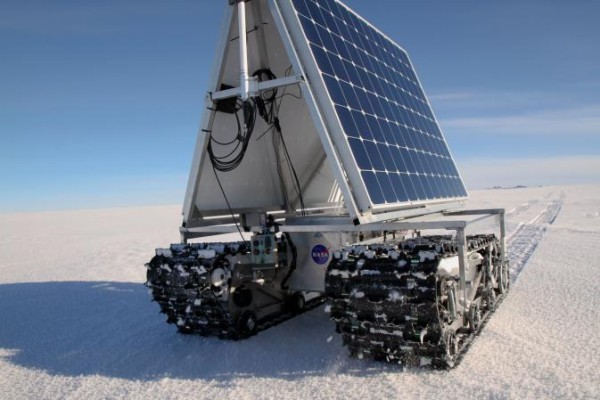NASA loves to power its various high tech projects with solar energy as an efficient and cost effective way for them to go longer out in the field. One of its most recent undertakings has been GROVER, which stands for both Greenland Rover and Goddard Remotely Operated Vehicle for Exploration and Research. Our partner Climate Central first mentioned back in May that NASA planned to test the remote control robot studying the layers of snow and ice that comprise the massive Greenland ice sheet. Fast forward to July, and it looks like this first test was passed with flying colors despite 30 mph gusts and temperatures down to minus 22 F.
GROVER was designed by by teams of students attending engineering boot camps at Goddard in the summers of 2010 and 2011 to carry a ground-penetrating radar that would analyze the terrain it went over. Handed over to Boise State for fine tuning, it went through initial testing at a beach in Maryland and in the snow in Idaho. The true experience came though went it ran through its Greenland paces May 6 to June 8 at Summit Camp, the highest spot on that icy body of land.

During its time in Greenland, one of the major goals of the GROVER deployment was proving that the robot could execute commands sent from afar over an Iridium satellite connection. It, according to NASA,
collected and stored radar data over 18 miles during the five weeks it spent on the ice. During the testing, the rover was also able to transmit information in real time on how its onboard systems were performing. The robot’s solar-charged batteries allowed it to operate for up to 12 hours before having to recharge.
While GROVER was on the ground, its radar emitted “a signal that bounces off the different layers of the ice sheet, allowing scientists to study how snow and ice accumulates in Greenland.” This helped researchers wondering “whether the robot could see a layer in the ice sheet that formed after an extreme melt event in the summer of 2012.” A first pass at the collected information revealed it was sufficient to detect the melt layer and potentially estimate its thickness.
For all its success, the project wasn’t without challenges for the 800 pound robot, which included the impact of extreme polar conditions on on-board electronics and the fact the uneven icy terrain required constant adjustments to speed and power so it wouldn’t get stuck.
Those behind GROVER next want to “switch to a geostationary satellite connection that will let the robot transmit large volumes of data in real time.” And, in a nod to making it more self-sufficient while using less energy, there are also plans for “merging the two onboard computers to reduce energy consumption, and using wind generators to create more power or adding a sled carrying additional solar panels.”
“When you work at the poles, on the ice, it’s cold, it’s tiring, it’s expensive and there’s a limit to how much ground you can cover on snowmobiles,” said Lora Koenig, a glaciologist at NASA’s Goddard Space Flight Center in Greenbelt, Md, in a statement. “It would be great if autonomous robotic platforms could do part of this work — especially the part where high winds and blowing snow try to freeze your skin.”